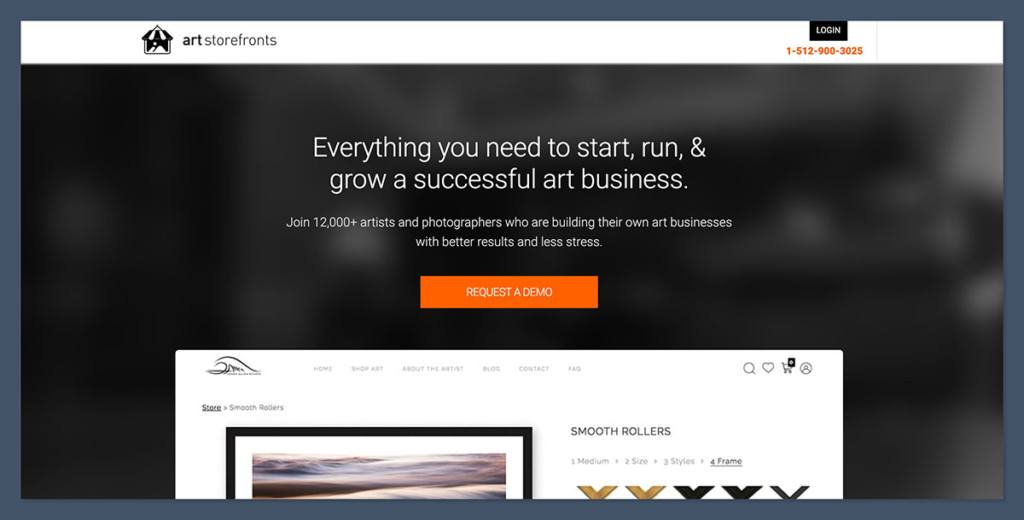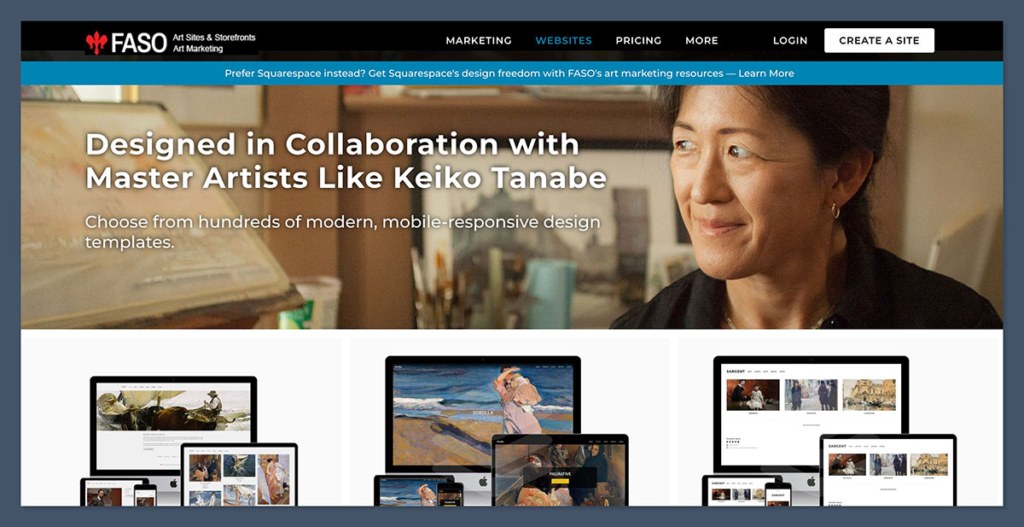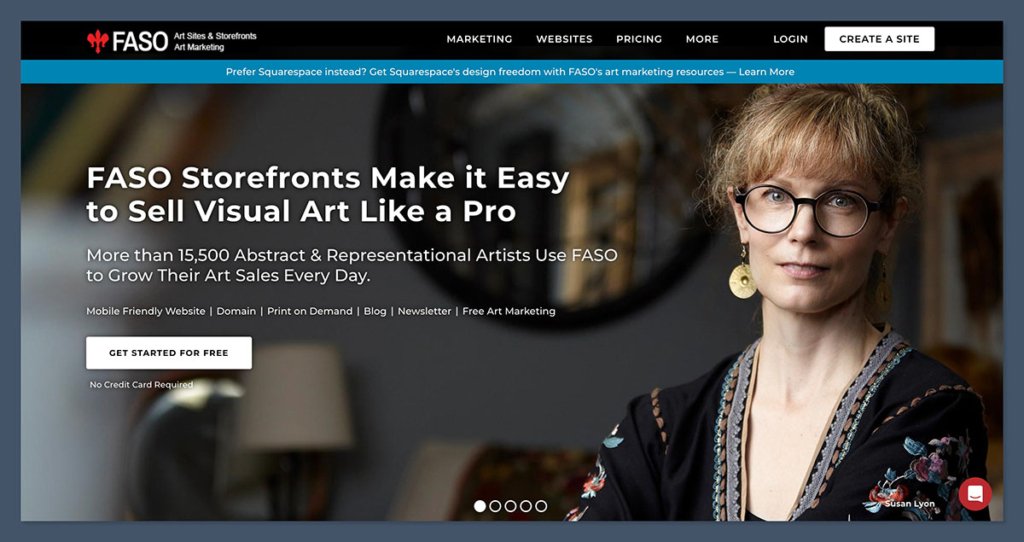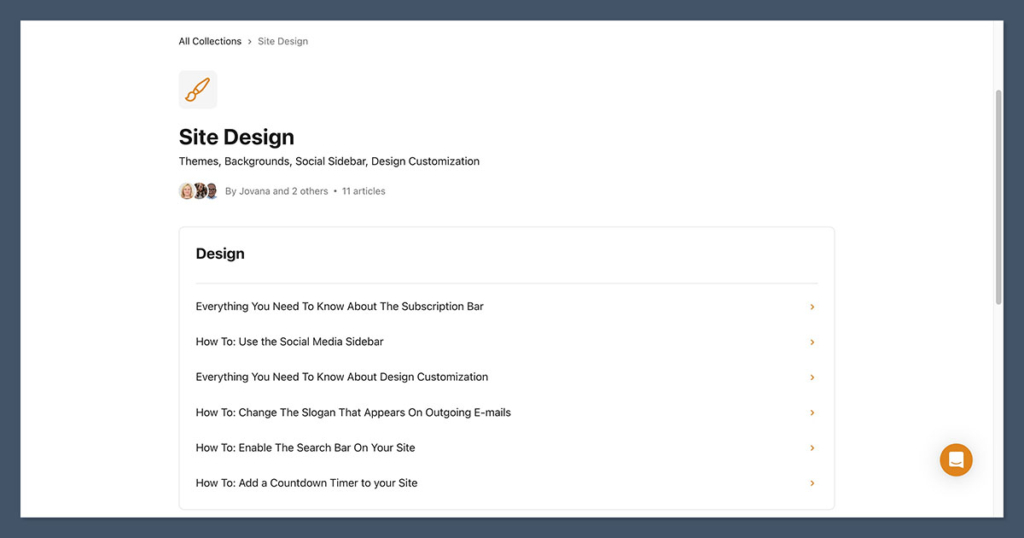
Quick answer: Art Storefronts is the better platform if you’re serious about growing an art business with advanced ecommerce and marketing tools.
FASO is a cheaper and easier option if you’re starting out and just want a clean portfolio website.
I’ve tested both Art Storefronts and FASO, spoken with artists using each platform, and reviewed their sales features, design options, support, and pricing.
Let’s dive into the details so you can figure out which one fits your art business goals.
Art Storefronts vs FASO: Quick Verdict
| Feature | Art Storefronts | FASO |
|---|---|---|
| Best For | Scaling an art business | Beginners building a portfolio |
| Starting Price | From $49/month + setup fee | From $12/month |
| Ecommerce Features | Advanced tools + fulfillment integration | Basic checkout and cart |
| Marketing Tools | Built-in automation + coaching | Email newsletters |
| Design & Templates | Modern, commerce-first | Simple, clean portfolios |
| Support | Live training, coaching, onboarding | Help docs + email support |
| Free Trial | No free trial (demo available) | 30-day free trial |
Best for Pricing: FASO Is Cheaper, But You Get What You Pay For
If price is your top concern, FASO is the more affordable choice by a long shot. Their plans start at just $12/month, and even the highest tier caps at around $40/month.
That makes it an easy pick for artists testing the waters or looking to showcase work without heavy ecommerce features.
Here’s how FASO’s pricing generally breaks down:
| FASO Plan | Monthly Price (USD) | Features Included |
|---|---|---|
| Intro | $12 | Basic portfolio, limited uploads, email capture |
| Standard | $18 | Blog, contact form, more artwork slots |
| Professional | $28 | Full ecommerce, SEO tools, email marketing |
| Ultimate | $40 | Priority support, higher storage, event calendar |
Art Storefronts, on the other hand, is priced for serious sellers. Plans start at around $49/month and can run well over $100/month depending on your plan tier and features.
On top of that, there’s a one-time onboarding fee that ranges from $500 to $2000.
That setup cost throws people off — but it’s not just for website creation. You’re getting a full ecommerce framework, personal onboarding, and marketing strategy setup.
Here’s what’s typically included with Art Storefronts:
- Print-on-demand integration with automatic fulfillment
- Built-in marketing automation for emails, promos, and traffic
- Access to a full coaching system with weekly training calls
- CRM, analytics, ad tracking, and conversion optimization tools
You’re not just paying for a website — you’re investing in a system that helps sell, fulfill, and scale your art sales.
| Art Storefronts Plan | Monthly Price (USD) | One-Time Fee (USD) | Key Benefits |
|---|---|---|---|
| Starter | $49+ | $500+ | Ecommerce, templates, basic marketing |
| Standard/Pro | $79–$129+ | $1000–$2000 | Full automation, coaching, advanced SEO |
| Custom Plans | Custom | Custom | Enterprise support, team accounts |
Verdict: FASO is affordable and great for beginners. But if you’re building a business, Art Storefronts is worth the investment.
The pricing reflects the depth of ecommerce and marketing power it gives you right out of the gate.
Best for Selling Online: Art Storefronts Has Real Ecommerce Power

This is where Art Storefronts pulls ahead, no contest.
If your goal is to turn your art into an income stream — not just display it — then ecommerce functionality matters. Art Storefronts was built for selling, and it shows.
Here’s what Art Storefronts offers that FASO doesn’t touch:
- Print-on-demand and fulfillment integration
No need to store, pack, or ship anything. Orders go straight to professional print labs and ship directly to your customers. - Real-time product mockups
Show your artwork on walls, framed, in rooms, and even in augmented reality to boost buyer confidence. - Cart abandonment recovery + advanced promotions
Use smart automations like abandoned cart emails, cross-sells, upsells, and discount timers to lift conversions. - Inventory and shipping logic
Control SKU-level stock management, shipping zones, tax rules, and even product variants. - Multiple payment gateways
Stripe and PayPal are built in, along with tax settings and order tracking from day one.
These tools are native to the platform. No third-party plugins, no external apps, no patchwork. Everything is built to sell from the ground up.
In comparison, FASO’s ecommerce setup is simple and functional — but limited.
You can:
- Add a basic shopping cart and checkout
- Sell originals, prints, and downloads
- Accept Stripe or PayPal for payments
But that’s where it ends. There’s:
- No fulfillment service
- No integrated marketing automation
- No cart recovery
- No product mockups
- No shipping automation
It works for casual selling or taking commissions, but if you want to scale — you’ll hit the ceiling fast.
| Feature | Art Storefronts | FASO |
|---|---|---|
| Print-on-demand | Yes | No |
| Automated fulfillment | Yes | No |
| Cart abandonment recovery | Yes | No |
| Cross-sells & upsells | Yes | No |
| Custom shipping & tax logic | Yes | Limited |
| Product mockups in real environments | Yes | No |
| Payment processors | Stripe, PayPal | Stripe, PayPal |
Verdict: If you want to sell a few pieces now and then, FASO works. But if you want to build a real art shop with serious ecommerce functionality, Art Storefronts is the clear choice. It’s built to sell, fulfill, and grow — all from one dashboard.
Best for Marketing Tools: Art Storefronts Has Built-In Automation and Coaching
Marketing is often where artists struggle — not because they’re not capable, but because the tools are usually too scattered, too technical, or just not built for creatives.
Art Storefronts understands that problem and has baked marketing directly into the platform.
Every subscription includes access to their “Success Plan”, which is a complete marketing system designed specifically for artists. It’s not just features — it’s a strategy.
Here’s what’s included:
- Pre-built email funnels
Ready-to-launch campaigns for announcements, sales, new collections, and more. You don’t have to write them from scratch. - Conversion-optimized templates
Designed with ecommerce best practices — not just pretty, but built to generate leads and sales. - SEO recommendations
On-page SEO guidance that helps your artwork pages and blog posts rank in search engines. - Ad tracking integrations
Built-in tracking for Facebook and Instagram campaigns. See what’s working and where your traffic is coming from. - Weekly live coaching calls
Attend real-time strategy sessions with experts who walk through seasonal promotions, launch strategies, and conversion tips. - Traffic analytics and CRM dashboard
Know who’s visiting, what they’re doing, and how to follow up.
On top of that, the dashboard lets you:
- Push artwork directly to Instagram
- Segment email lists by behavior or interest
- Schedule promotions in advance with timers and automation
- Monitor customer journeys and repeat buyer behavior
In short — you get a real marketing system, not just a website.
FASO, to its credit, does include some foundational tools:
- A basic newsletter tool for email blasts
- A built-in blog for sharing stories or updates
- Social media buttons and sharing features
But that’s where it ends. There’s no automation, no funnel builder, no list segmentation, and no campaign-level analytics.
| Feature | Art Storefronts | FASO |
|---|---|---|
| Email funnels | Pre-built and automated | Manual newsletters |
| Templates | Optimised for conversion | Portfolio-focused |
| SEO tools | Guided and built-in | Manual input only |
| Ad tracking | Facebook/Instagram integrations | None |
| Coaching & training | Weekly live calls included | None |
| Analytics and CRM | Full dashboard | Basic traffic stats |
| Social tools | Direct-to-Instagram, scheduling | Share buttons only |
Verdict: If you want to drive traffic and convert visitors into buyers, Art Storefronts gives you the tools and support to do it. It’s a marketing platform wrapped in a website builder.
FASO gives you the basics, but you’re on your own from there.
Best for SEO and Visibility: Art Storefronts Leads Again
Let’s talk search engines. If no one finds your art, they can’t buy it. And that’s exactly why SEO is make-or-break for online art sales.
Art Storefronts takes SEO seriously, and it shows in how the platform is built — not just on the front end, but deep into the backend architecture.
Here’s what you get with Art Storefronts:
- Clean site architecture
Every page is crawlable, properly structured, and built to index well in Google. - Structured data markup
Your artwork includes rich data that helps search engines understand what the content is — like prices, dimensions, and availability. - Image optimization
Automatic compression and alt tagging support keep load times fast and visuals accessible. - Editable SEO elements
Title tags, meta descriptions, and URLs are fully customizable — on every artwork and page. - Speed-optimized templates
Fast-loading pages are critical for ranking. Their themes are built with performance in mind. - Built-in SEO coaching and audits
Their team walks you through how to set up your site properly and gives feedback along the way.
So instead of piecing together SEO on your own, you’re guided through it, with built-in support and tools already in place.
By comparison, FASO supports the basics, but that’s where it ends. You can:
- Add alt tags, title tags, and meta descriptions manually
- Take advantage of mobile-friendly designs
- Write blog content that can be indexed
But there’s:
- No technical SEO support
- No structured data
- No built-in audits
- No guidance for rankings or keyword strategy
It’s up to you to know what you’re doing — or to hire outside help.
| SEO Feature | Art Storefronts | FASO |
|---|---|---|
| Title tag and meta editing | Yes | Yes |
| Structured data markup | Yes | No |
| Page speed optimization | Yes | Yes |
| Image compression + alt tags | Automatic and manual | Manual only |
| SEO training or coaching | Included with subscription | None |
| On-page SEO audits | Built-in | No |
| Blog SEO | Yes | Yes |
Verdict: FASO gets you started with SEO, but it’s up to you to build on it. Art Storefronts helps you rank and convert by combining technical SEO foundations with real-time support and education.
For artists serious about growing organic traffic, that extra structure makes a big difference.
Best for Templates & Design: Different Styles, Same Limitations
Design is personal — and when it comes to your online presence, it should reflect both your art and your business goals.
Art Storefronts and FASO take very different approaches here, and which one works best depends on what you’re trying to achieve.
Art Storefronts: Built for Sales
Art Storefronts offers modern, conversion-focused templates. They’re designed not just to look good, but to drive action. Each layout is structured to:
- Be fully mobile-optimised, so your site looks great on any device
- Showcase artwork front and center with large hero images and product galleries
- Include built-in buy buttons, pricing, and cart logic directly on each artwork page
There are several storefront styles available, ranging from minimal to bold. But no matter the look, every layout is focused on moving a visitor from browsing to buying.
You also get features like:
- Featured collections on the homepage
- Smart filtering by collection or media type
- Sticky navigation and embedded promotions
It’s a sales-first design philosophy, backed by ecommerce logic.
FASO: Clean Portfolios, Minimal Commerce

FASO templates lean heavily into the portfolio website category. They’re designed for showcasing art, not necessarily selling it.
What you’ll find:
- Clean, image-heavy layouts
- Minimalist typography and neutral colours
- Simple navigation and gallery-style grids
These designs work well if your goal is to display your work, share your story, and maybe take commissions. But they aren’t structured to support full ecommerce journeys. You’ll need to rely on basic add-to-cart functionality — and there’s less control over layout, content blocks, or homepage elements.
Design Flexibility: Limited on Both
Neither platform offers a true drag-and-drop builder like Wix or Squarespace.
You’re choosing a template and working within its structure. You can update content, images, colours, and some layout options — but deeper customization requires workarounds or developer help.
| Feature | Art Storefronts | FASO |
|---|---|---|
| Mobile responsive | Yes | Yes |
| Ecommerce elements in templates | Built-in | Minimal |
| Portfolio-first design | Optional | Yes |
| Drag-and-drop builder | No | No |
| Template customization | Moderate | Basic |
| Template variety | Several storefront styles | Several minimalist options |
| Designed for sales | Yes | No |
Verdict: Want a portfolio? Go FASO. It’s quick, clean, and made for showcasing art.
Want a store that looks like a gallery but functions like Shopify? Go Art Storefronts. The templates are built to help you turn visitors into buyers — not just viewers.
Best for Ease of Use: FASO Is Simpler, Art Storefronts Is Heavier But Deeper

If your priority is getting online fast with minimal hassle, FASO wins hands down. It’s built for artists who want to get their work published and visible without having to learn an entirely new platform.
The interface is clean and designed for simplicity. You can get a site live in less than 30 minutes.
Here’s how easy it is to add artwork on FASO:
- Upload your image
- Add a title and description
- Set the price
- Hit publish
That’s it. The dashboard is uncluttered, and the navigation is straightforward. Even artists with limited technical experience find it easy to use.
There’s no guesswork involved, and the support docs are easy to follow if you get stuck.
By contrast, Art Storefronts has a steeper learning curve, but it’s because the platform goes far beyond just uploading and displaying images.
You’re not just managing a website — you’re managing a full ecommerce backend.
Here’s what you’re working with in Art Storefronts:
- Order tracking system for managing sales, shipping, and customer status
- Print-on-demand fulfillment routing, connecting directly to print labs
- Email marketing automations that segment audiences and schedule sequences
- Marketing setup wizards that help you build your campaigns and launch strategies
- Product variant options, tax setup, discount logic, and analytics
It takes time to learn how all the parts work together, but once you do, you have full control over the engine that runs your art business.
| Feature | FASO | Art Storefronts |
|---|---|---|
| Time to first published piece | Under 30 minutes | 1–2 hours with onboarding |
| Dashboard complexity | Simple and minimal | Advanced with more tools |
| Artwork upload process | 3–4 steps | 6–10 steps (more detail required) |
| Ecommerce configuration | Basic (price and checkout) | Full logic (shipping, tax, POD) |
| Learning curve | Low | Moderate to high |
| Training and onboarding | None | Included with setup |
Verdict: FASO is easier. You’ll get set up fast and without friction.
Art Storefronts is more powerful, but requires more time and effort upfront to learn the platform. That investment pays off if you’re looking to scale — but it’s not instant.
Best for Support: Art Storefronts Has Coaching, FASO Has Docs

This is where the gap between the two platforms becomes very clear. Support isn’t just about fixing issues — it’s about helping you grow.
Art Storefronts approaches support as part of your overall business strategy. You’re not left to figure it all out on your own. Instead, they guide you step-by-step through setup, marketing, selling, and scaling.
Here’s what Art Storefronts provides:
- 1-on-1 onboarding calls
A dedicated team member walks you through your setup, pricing strategy, and core features. - Weekly live coaching sessions
Learn how to launch promotions, build an email list, optimize for SEO, and run paid ads — all guided by pros. - Community support groups
Collaborate with other artists, ask questions, and see how others are using the platform to grow. - Video tutorials and implementation checklists
Short, practical guides show you exactly what to do, step by step. - Priority support via chat and email
Fast response times and real people who understand the platform and the business of selling art.
Whether you’re setting up your first gallery page or trying to retarget abandoned carts, their team is there to help you do it right the first time.
FASO, on the other hand, sticks with a traditional support model:
- A library of help articles and documentation
- Email support, typically during business hours
- A handful of tutorial videos on getting started
It’s functional and generally reliable, but it’s reactive, not strategic. You reach out when something breaks or if you’re unsure how to use a feature — not when you’re trying to grow or improve.
| Support Feature | Art Storefronts | FASO |
|---|---|---|
| 1-on-1 onboarding | Yes | No |
| Live coaching sessions | Weekly | No |
| Support community | Yes | No |
| Help docs and tutorials | Yes | Yes |
| Email support | Priority and fast | Standard (limited hours) |
| Chat support | Included | Not available |
| Proactive business support | Yes | No |
Verdict: FASO is self-service. Art Storefronts is a partnership. If you’re comfortable navigating things alone, FASO can work.
But if you want hands-on help, growth-focused advice, and a team that’s invested in your results, Art Storefronts delivers that support at every step.
Final Verdict: Art Storefronts Wins for Business Builders, FASO Wins for Beginners
When it comes down to it, the right platform depends on what stage you’re at — and what you want out of your online presence.
If you’re an artist who wants a simple, beautiful portfolio to display your work, FASO is the better choice.
It’s built for ease, priced affordably, and gives you all the essentials to get online fast. You won’t find complex settings or advanced tools — and that’s exactly why some artists love it.
It’s ideal if you:
- Want a clean online portfolio without the pressure to sell
- Prefer simplicity over customisation
- Don’t need advanced ecommerce or marketing features
- Are testing the waters or showcasing a commission-based practice
But if your goal is to build a profitable, scalable art business, Art Storefronts is the smarter, more complete platform. It’s designed specifically for artists who are serious about selling.
Yes, there’s a higher price tag. Yes, there’s more to learn. But the trade-off is that you’re not just getting a website — you’re getting an end-to-end sales and marketing system.
Choose Art Storefronts if you want to:
- Sell prints, originals, or digital products at scale
- Use automated fulfillment without managing inventory
- Run email marketing campaigns and grow a subscriber list
- Track customer behavior, optimize conversion, and increase repeat sales
- Build a system that supports long-term business growth
Here’s a quick recap:
| Who It’s For | Art Storefronts | FASO |
|---|---|---|
| Skill level | Intermediate to advanced | Beginner |
| Website purpose | Full ecommerce + marketing system | Simple portfolio |
| Fulfillment | Print-on-demand integration | Manual or not included |
| Marketing tools | Built-in automation + coaching | Basic newsletters only |
| Cost | $49–$129/month + setup fee | $12–$40/month |
| Best for | Business builders and full-time artists | Hobbyists and emerging artists |
Final Thought:
If you want a minimalist online gallery, go with FASO.
If you want a platform that helps you sell more, automate more, and grow faster, Art Storefronts is worth every dollar.
It’s not just about having a website — it’s about building a business that actually works while you focus on making the art.






